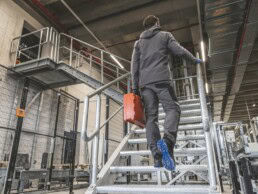Imagine entering a company where safety is not just a regulation but a true value – a company where every leader actively takes responsibility for occupational safety and employees feel safe and supported. That is exactly what Safety Leadership is. A vibrant and positive safety culture where the well-being of each individual comes first. Learn how Safety Leadership forms the foundation for safe work environments and successful teams.
What is Safety Leadership?
Safety Leadership is a leadership approach that focuses on safety and health in the workplace.
- The term originates from high-risk industries such as aviation, oil, and nuclear, where workplace accidents have dramatic consequences.
- In the 1980s and 1990s, scientists like James Reason (Swiss Cheese Model), Andrew Hopkins, and Sidney Dekker advanced Safety Leadership.
- Furthermore, companies like DuPont Corporation significantly contributed to the spread of behavior-oriented safety approaches.
- It was important to understand that accidents are not only due to technical failures, but often arise from behavioral errors, lack of communication, or unsafe decisions, and that employees strongly orient themselves to the behavior of their leaders.
- A strong safety culture demonstrably reduces accidents, downtime, and costs. It also increases trust and performance within the team.

Unlike the traditional occupational safety leadership style, which often focuses on mere compliance with regulations, Safety Leadership aims to establish a safety culture throughout the company. Leaders take an active role in promoting a positive safety mindset among their employees.
An effective Safety Leader leads by example. He shows through his own behavior how important occupational safety is and motivates his team to also engage in safety. He ensures that employees are regularly trained in educational institutions, such as the uvex academy, and receive all relevant safety instructions. He also ensures that risks are identified early and appropriate measures are taken to prevent workplace accidents.
Unlike the traditional leadership style, which often focuses on control and compliance with regulations, Safety Leadership is based on:
- Trust
- Communication
- Responsibility of each individual
The leader creates an environment where safety is not just a goal but a continuous task. This not only contributes to reducing risks but also promotes the well-being and motivation of employees.

What is the Theory of Safety Leadership?
The theory of safety leadership is based on the realization that leaders play a key role in promoting safety culture and occupational safety. An effective leadership style in the field of occupational safety combines various models that target the behavior and attitudes of employees. Two particularly relevant models are behavior-based safety and transformational leadership. (Martin Grill et al., 2023 / Hu Shi, 2022 / Calvin J. Manjarres-Wahlberg, 2024)
The Behavior-Based Safety Model:

This model focuses on improving safety behavior through targeted training and continuous feedback. Leaders act as role models and actively demonstrate safety standards.
| Behavior-Based Safety Model | |
| Aspect | Description |
| Goal | Strengthening safety behavior through targeted training and continuous feedback |
| Role of Leadership | Leaders act as role models and demonstrate safety in practice |
| Leadership Task | Motivate employees to take responsibility for occupational safety |
| Measures | – Regular safety briefings – Continuous feedback – Promotion through positive role models |
| Psychological Basis | Fostering a positive safety mindset through role modeling and clear communication |
| Outcome | Increased employee motivation and better implementation of safety measures in daily work |
Model of Transformational Leadership:
In contrast to behavior-based safety, Transformational Leadership aims to establish a long-term safety culture by changing employees’ attitudes and behaviors. It places greater emphasis on personal development and emotional motivation.
| Model of Transformational Leadership | |
| Aspect | Description |
| Goal | Changing employees’ attitudes and behaviors through inspiration and motivation |
| Role of Leadership | Leaders act as mentors and visionaries who encourage employees to adopt a proactive approach to safety |
| Leadership Task | – Create inspiring visions for safety – Motivate employees to take personal responsibility for occupational safety |
| Measures | – Promote trust and recognition – Open communication of safety goals and values – Regular feedback discussions |
| Psychological Basis | Developing a safety mindset and strengthening employees’ sense of responsibility for their own safety and that of their colleagues |
| Outcome | Improved occupational safety through long-term cultural change and a proactive employee attitude |
Psychological aspects are crucial. Through specific actions and behaviors, leaders have a significant influence on how employees perceive and integrate safety practices into their daily work.
- By building trust and establishing an open communication culture, leaders foster a positive safety mindset.
- Safety should not be seen as an isolated goal, but as an integral part of daily work.
- When safety measures are communicated transparently and employees are actively involved in the safety process, motivation increases and accident rates are significantly reduced.
What Role Does Leadership Play in Safety?
Among the essential tasks of a safety leader are safety instructions and regular training. These help to promote the safety mindset and keep knowledge about occupational safety up to date.

An Example of the Role of Leaders in Occupational Safety
When a leader regularly wears protective equipment and strictly adheres to safety regulations, this is perceived by employees as the standard. Their behavior directly influences the safety awareness of employees. If leaders confidently pay attention to safety, employees often adopt this attitude and transfer it to their daily work.
A good example of this is the production manager who works both in the office and in manufacturing. As a good safety role model, he consciously changes his business shoes for safety shoes when he leaves his office and enters the production hall.
Another central role of leadership is risk management. Leaders must identify risks early, analyze them, and take appropriate measures to prevent workplace accidents. Their task is to develop a safety strategy and monitor its implementation. In this way, they actively contribute to reducing workplace accidents.
This can be well illustrated with an example:
- The production manager of a company notices an unusual noise from a machine.
- He analyzes the cause and finds that a safety mechanism may have failed.
- To prevent a possible accident, he immediately arranges for a repair. He takes the time and effort to implement the maintenance.
- In this way, he ensures that all employees are informed about the potential danger.
- In addition, as a safety ambassador, he proactively shows that measures to ensure safety must be carried out immediately.
Safety Culture and Safety Mindset
A strong safety culture is the foundation for successful safety leadership in any company. It promotes a shared awareness of safety and responsibility that goes far beyond mere compliance with regulations. While a safety mindset reflects the attitude that safety is not just a set of rules, but a mindset, mere compliance often only concerns the minimum. A strong safety mindset means that safety is embedded in the daily processes of a company and actively lived by all employees.
- Through clear communication channels and the provision of regular training, some large companies have successfully built a safety culture.
- Leaders and managers exemplify the values of safety and ensure through concrete measures that occupational safety is integrated in all processes.
- Through their active commitment, a positive safety culture is secured in the long term and occupational safety is effectively improved.

What Does a Safety Manager Do?
A safety manager plays a significant role in embodying safety leadership within the company. He or she develops safety strategies and implement targeted measures to minimize risks and protect the health of employees:
- Coordination of safety processes
- Regular instructions to ensure compliance with legal regulations
- Motivation of employees
- Communication at eye level
- Proactive behavior
An important part of their work is communication. They speak at eye level with leaders and employees, motivate safe behavior, and thus promote a strong safety culture. Safety managers also communicate with other areas of the occupational safety organization (such as company doctors, safety specialists, fire protection officers) to organize and plan occupational safety within the company.
The difference from purely administrative tasks: safety managers are proactive and close to the action. As promoters of the safety culture, they analyze accident rates, conduct inspections and audits, evaluate training results, and derive concrete measures from them:
- Reporting points for unsafe conditions
- Feedback channels for employees
- Development of prevention strategies and their follow-up
- Ergonomic workplace design
- Safety campaigns and awareness actions
- Training of leaders for a successful role model function
- Target agreements and evaluations
These measures are crucial to bundling the commitment of leaders and employees to a safety culture and implementing successful safety leadership in the company.